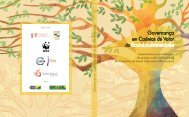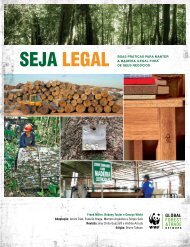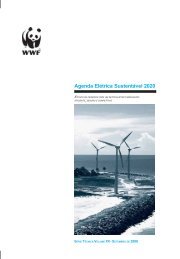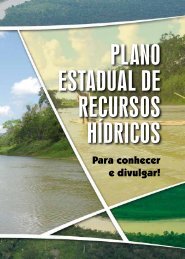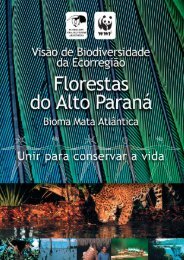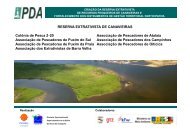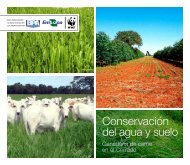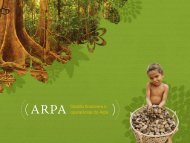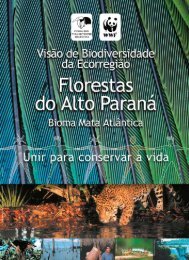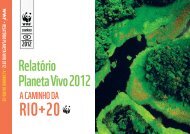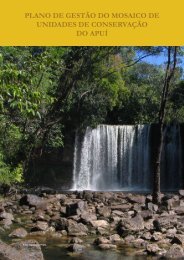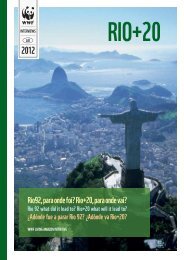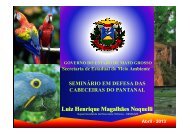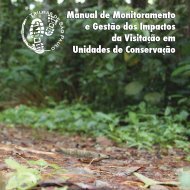Visão de Biodiversidade da Ecorregião Serra do Mar
Visão de Biodiversidade da Ecorregião Serra do Mar
Visão de Biodiversidade da Ecorregião Serra do Mar
- No tags were found...
Create successful ePaper yourself
Turn your PDF publications into a flip-book with our unique Google optimized e-Paper software.
Visão <strong>de</strong> Biodiversi<strong>da</strong><strong>de</strong> <strong>da</strong> Ecorregião <strong>Serra</strong> <strong>do</strong> <strong>Mar</strong>53Tabela 2. Metas <strong>de</strong> conservação a<strong>do</strong>ta<strong>da</strong>s para as UFGs em hectaresUni<strong>da</strong><strong>de</strong>fitogeomorfológicaáreapotencialárea2004Per<strong>da</strong> (%)meta <strong>de</strong>retençãometa <strong>de</strong>vulnerabili<strong>da</strong><strong>de</strong>metatotal comcorreção<strong>do</strong> limiarfloresta ombrófila<strong>de</strong>nsa montana <strong>da</strong><strong>Serra</strong> <strong>da</strong> Mantiqueirafloresta ombrófila<strong>de</strong>nsa montana <strong>do</strong>Planalto <strong>de</strong> São Bento<strong>do</strong> sulfloresta estacionalsemi<strong>de</strong>cidual <strong>do</strong>Maciço <strong>do</strong> Caparaófloresta ombrófila<strong>de</strong>nsa <strong>da</strong> Depressão <strong>do</strong>Lagamarestepe caatingaarbórea aberta507,925 254,334 50 76,300 114,450 114,45042,780 40,431 5 12,129 12,736 12,73691,990 22,008 76 6,603 11,620 11,62020,648 20,030 3 6,009 6,189 10,0007,171 247 96 74 145 247Estimou-se um valor <strong>de</strong> vulnerabili<strong>da</strong><strong>de</strong> para as UFGs consi<strong>de</strong>ran<strong>do</strong>-se a conversãodiferencial <strong>da</strong>s diferentes fisionomias vegetais. As UFGs foram classifica<strong>da</strong>s em 4níveis <strong>de</strong> acor<strong>do</strong> com a pressão <strong>de</strong> <strong>de</strong>gra<strong>da</strong>ção a que foram submeti<strong>da</strong>s avalia<strong>da</strong>pela razão entre área remanescente e área original. Deste mo<strong>do</strong>, formaçõescom áreas remanescentes menores e mais ameaça<strong>da</strong>s receberam um valor <strong>de</strong>vulnerabili<strong>da</strong><strong>de</strong> maior em uma escala crescente <strong>de</strong> 1 a 4 (Tabela 3). A lista completa<strong>de</strong> UFGs, área original, área remanescente, razão área remanescente/área original e<strong>de</strong> vulnerabili<strong>da</strong><strong>de</strong> é apresenta<strong>da</strong> no Anexo II.Tabela 3. Classes <strong>de</strong> vulnerabili<strong>da</strong><strong>de</strong> a<strong>do</strong>ta<strong>da</strong>s para as UFGs.Vulnerabili<strong>da</strong><strong>de</strong> Limite <strong>da</strong>s classes N° <strong>de</strong> UFGs1 1 – 0,75 422 0,75 – 0,5 103 0,5 – 0,25 164 0,25 – 0 16UNIR PARA CONSERVAR A VIDA



